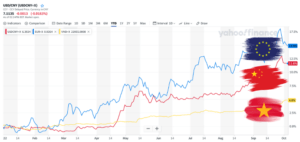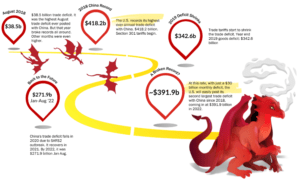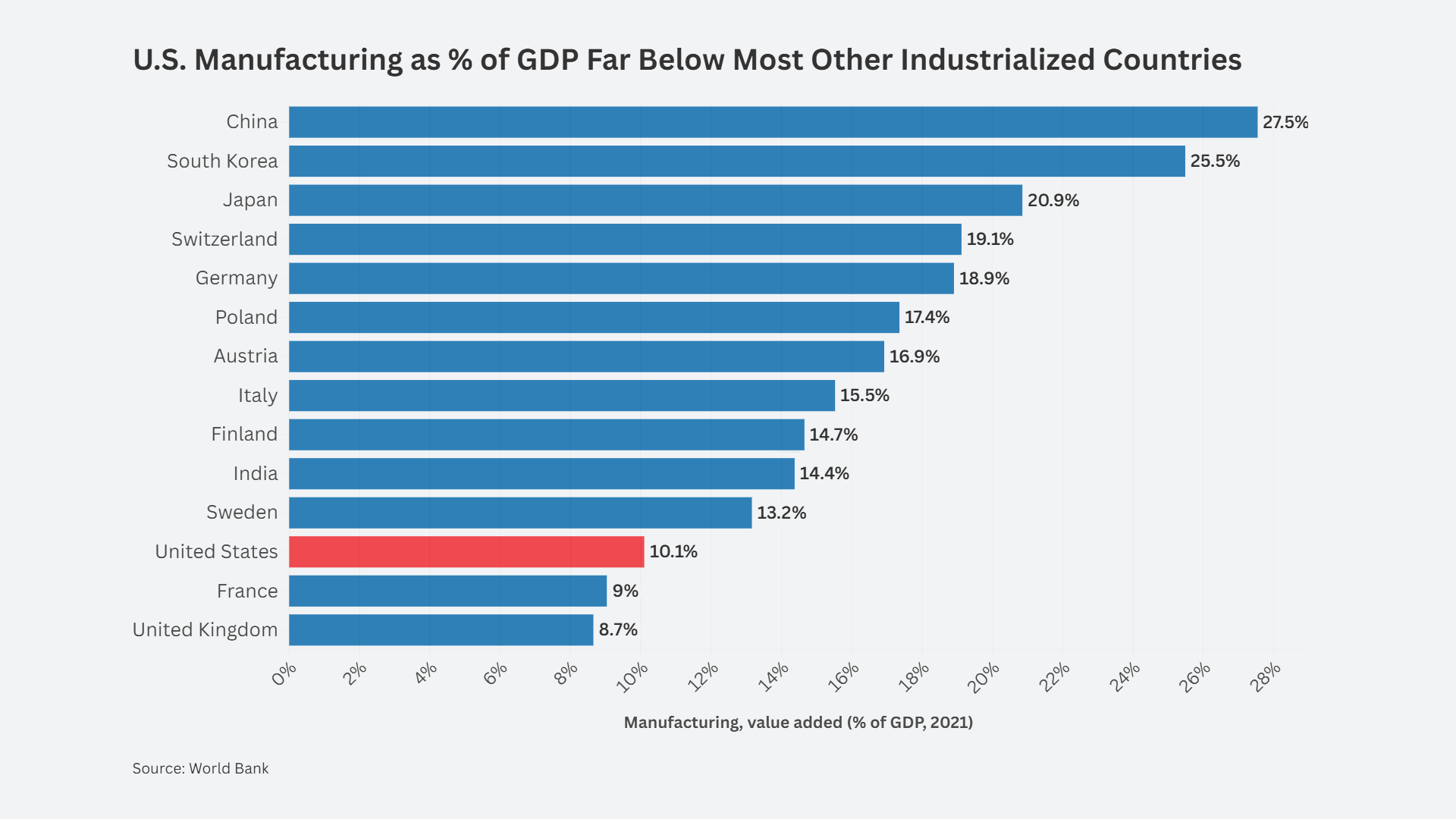The U.S. goods and services trade deficit declined 4.3% to $67.4 billion in August. In percentage terms, it was imports that declined the most in both goods and services. But for the goods trade alone, the deficit hit its lowest monthly figure on the year — $87.6 billion in August compared to $91 billion in July and $99 billion in June. Today’s trade chart shows a continued drop in demand as the economy slides into a recession.
 The interesting figure in Wednesday’s release from the Bureau of Economic Analysis is that while U.S. imports from most trading partners fell, our $37.4 billion trade gap with China was the highest August deficit since August 2018 when it was over $38 billion on a nominal basis. That year was a record-breaking year for China imports. Pent-up demand due to China’s pandemic lockdowns are the likely cause.
The interesting figure in Wednesday’s release from the Bureau of Economic Analysis is that while U.S. imports from most trading partners fell, our $37.4 billion trade gap with China was the highest August deficit since August 2018 when it was over $38 billion on a nominal basis. That year was a record-breaking year for China imports. Pent-up demand due to China’s pandemic lockdowns are the likely cause.
Despite the economic slowdown everyone is predicting, the U.S. trade deficit will undoubtedly break another record as we start the fourth quarter.
Year-to-date, the goods and services trade deficit is already 24.4% higher than the same period last year at $674.04 billion ending in August.
The year-to-date goods deficit is $830.9 billion, up from $709.1 billion in the January-August 2021 period.
If the U.S. posts an average deficit per month of $80 billion over the next four months, the year-end goods trade deficit will break last year’s record of $1.09 trillion and easily topple $1.15 trillion. Barring a steeper than expected slowdown this quarter, a $1.1 trillion goods deficit is guaranteed.
See the CPA Trade Database for a monthly breakdown of the trade deficit.

A look at dollar gains versus the euro, renminbi and the Vietnamese dong.
Strong Dollar: Only Game in Town
One of the often overlooked reasons for the trade deficit is currency misalignment. The financial press has been commenting on the dollar’s strength against other core economies all summer long. The renminbi hit a five-year low of 7.248 to the dollar during intraday trading earlier this month. It is still trading above 7 to 1.
The euro is at its weakest level against the dollar in 10 years; even the Mexican peso has held its own against the dollar better than the world’s second-largest reserve currency.
“The incredible runup in the dollar this year will increase imports not just this year but over the next couple of years, with dire consequences for domestic U.S. manufacturing production and employment,” said CPA Chief Economist Jeff Ferry.
The dollar index, which measures the dollar’s strength against a basket of major currencies, hit a 20-year high of 114.78 last week. A level number of 100 is considered “par” value with other currencies, with numbers below 100 meaning a weaker dollar.
Assuming dollar strength remains above 100, we should expect consistently high monthly deficits (over $85 billion) that will make it harder for U.S. companies to sell their wares abroad, and make importing manufactured goods – in many cases – much cheaper than buying locally produced ones.
Trade Figures at a Glance
August’s trade figures show an economy pumping its brakes.
Exports of industrial supplies and materials fell by $2.2 billion. Automotive exports declined $1.1 billion, including car parts. U.S. imports of industrial supplies and materials fell even more than exports, dropping by $4.7 billion. Crude oil imports fell $2.7 billion and semiconductor imports fell by around $500 million.
The August figures show surpluses, in billions of dollars, with South and Central America ($7.1),
The U.S. managed to post a billion-dollar goods surplus with The Netherlands ($4.2 billion), Hong Kong ($2.3 billion), United Kingdom ($1.2 billion), Australia ($1.1 billion), and Brazil ($1 billion). Billion-dollar deficits were also recorded with the usual: China ($33.5 billion on a Census basis), European Union ($13.5 billion), Mexico ($9.8 billion), Vietnam ($9.6 billion), Canada ($7.4 billion), Ireland ($5.2 billion), Germany ($5 billion), Taiwan ($4 billion), Italy ($4 billion), Japan ($3.6 billion), South Korea ($3.1 billion), India ($3.1 billion), and Malaysia ($2.5 billion).
 China remains the standout. At this rate, the U.S. is easily heading for its second largest-ever trade deficit with China. A weakening renminbi is also a good luck charm for importers of Made in China.
China remains the standout. At this rate, the U.S. is easily heading for its second largest-ever trade deficit with China. A weakening renminbi is also a good luck charm for importers of Made in China.













